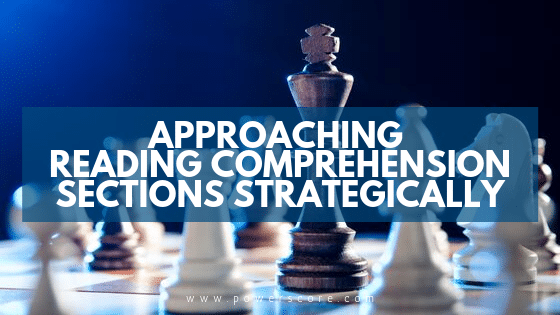Approaching the LSAT Strategically Series: Part I, Part II, Part III
There is a fundamental truth about test takers when it comes to the LSAT: everyone is different. That is, everyone who sits down with this exam will have unique strengths and weaknesses, likes and dislikes, and ultimately, ways they can optimize their performance in every section. While that certainly affects how it is that people prepare, I think it also dictates how test takers should behave during the actual test. In this three-part blog series, we will look at each of the section types on the LSAT and consider exactly how an informed test taker should attack each type. The first post examines Logic Games. Here, we will dive into Reading Comprehension.
Reading Comprehension
As we did with Logic Games, let’s consider a few facts about Reading Comprehension before we talk strategy.
- The four passages will be a mix of several different types given in no predictable order. Typically, you will see a science-based passage, a law-related passage, a passage drawn from a more humanities-type discipline, and then something else. Usually, you can expect a mix of various elements, although generally not another law or science.
- The passages are not necessarily presented in order of difficulty, either from easiest to hardest, or vice versa.
- “Difficulty” itself is dependent on both the nature of the passage and its questions, as well as your personal preferences and abilities.
Difficulty is Relative
Unlike Games, the difficulty of a Reading Comp passage is much harder to anticipate from the outset. That is, a passage about any topic can be straightforward or extremely challenging. But, recognizing the extent of its difficulty is nearly impossible until you’re deep into reading it or answering the questions. Similarly, you may find that you have preferences for topics or passage types. However, that serves as little indication of inherent difficulty or potential performance. Note that “preference” is a relative word here. It’s a rare occasion to meet a student who “prefers” Reading Comp to, well to nearly anything. But, within the section it’s likely that some passages will be more enjoyable, or produce a stronger performance, than others.
How to Approach Reading Comp
What do these “truths” about Reading Comprehension, particularly the third point, necessitate in terms of strategy? While perhaps less imperative than with Games, you should still consider the four passages individually and let personal preferences guide you. Couple your knowledge that you will encounter different topics in random order with your understanding of the topics/types you prefer. Quickly scan the four passages and determine the order that is most preferable to you. Don’t just dive in to the first passage and start grinding through it! At least, not until you consider the other passages relative to your experiences.
This idea is particularly applicable if you are, like many students, only planning to attempt three of the four passages! If that’s the case, you must make every effort to select the passages that present the highest likelihood of rewarding you with the most points. The preferences you develop while practicing should serve to influence that decision. Further, the question count for each passage plays an even more important role here than it did for Logic Games. Reading Comp requires a lot of upfront investment (the actual reading) before you can collect your points in the questions. So, when deciding between passages, if there is no immediately compelling topic or type preference, go with the passage that has more questions. Again, this is the “more bang for your buck” idea. It’s an especially important one to keep in mind for Reading Comprehension.
To repeat a point made in the last post, the advantages to this strategy of adaptive attack are multi-fold. It allows you to begin the section with a potentially successful and rewarding experience. That will establish confidence and momentum while also ensuring that your time in the section is well spent. Your time is valuable. Focus on passages where your odds of a strong performance are high and the number of questions allows for the greatest return on your investment.
Final Thoughts
Finally, we once again have a couple of ideas to consider as we wrap up this discussion.
- As always, maintain a high degree of self-awareness as you move through individual passages. Some passages may seem representative of past experiences where you have been successful, but as you begin reading you may find that they are much more difficult than anticipated. If that’s the case, the best decision may be to stop reading and move to a different passage. Don’t waste time trying to decipher text that is more confusing than you expected.
- On a related note, some questions are likely to be more difficult, or more time-consuming, than others. It may be wise to make an educated guess and move on. As wise test takers know, just because you initially commit to something, be it passage or question, does not mean you absolutely must see it through. Choosing to spend your time elsewhere can be an extremely prudent decision in a number of situations. After all, making prudent decisions is the key to reaching your full potential on the LSAT.
In Part 3 of this series, we examine Logical Reasoning and the elements therein. We look at exactly how an adaptive approach to these questions allows for the best possible experience on test day.


Leave a Reply